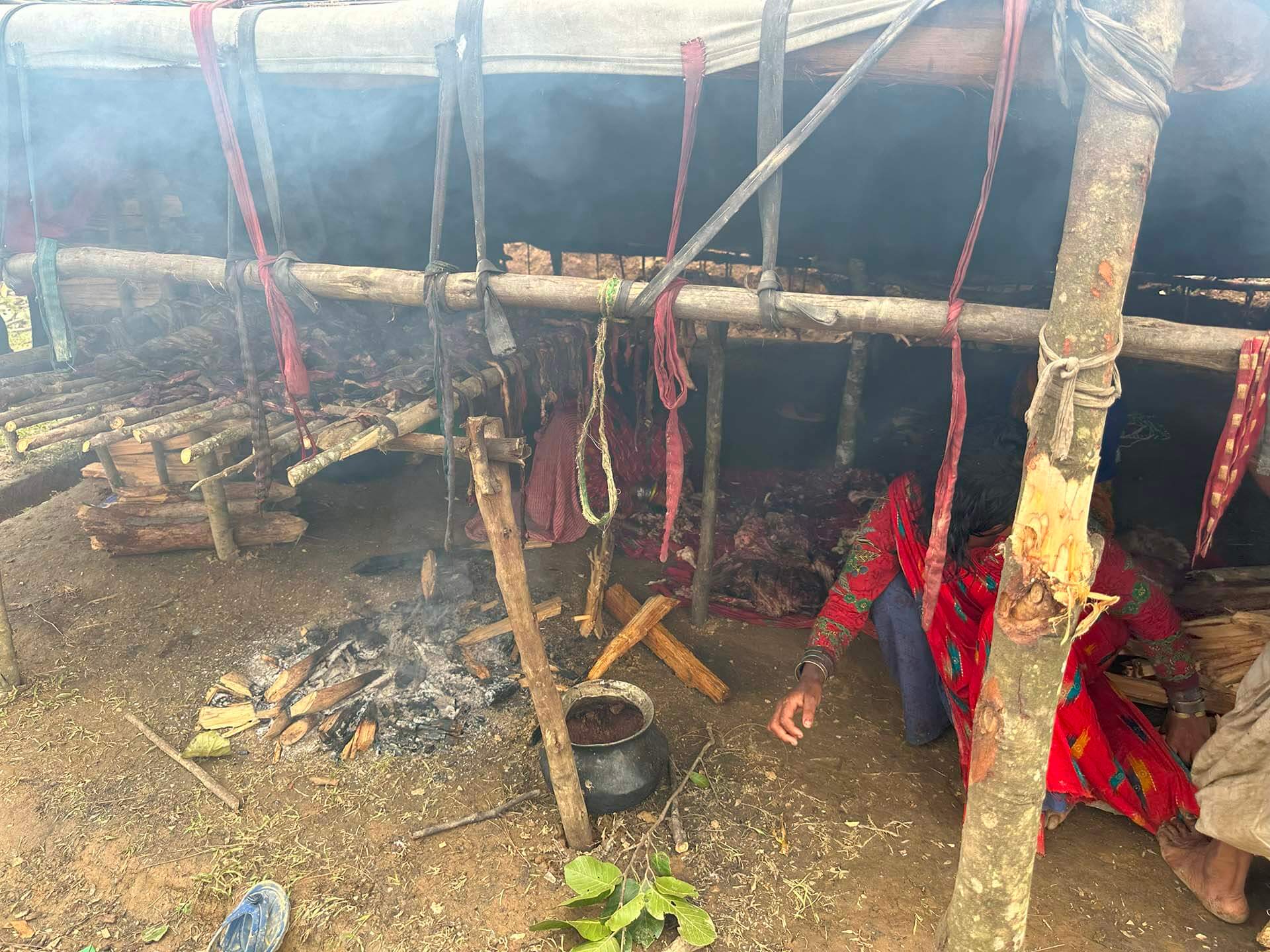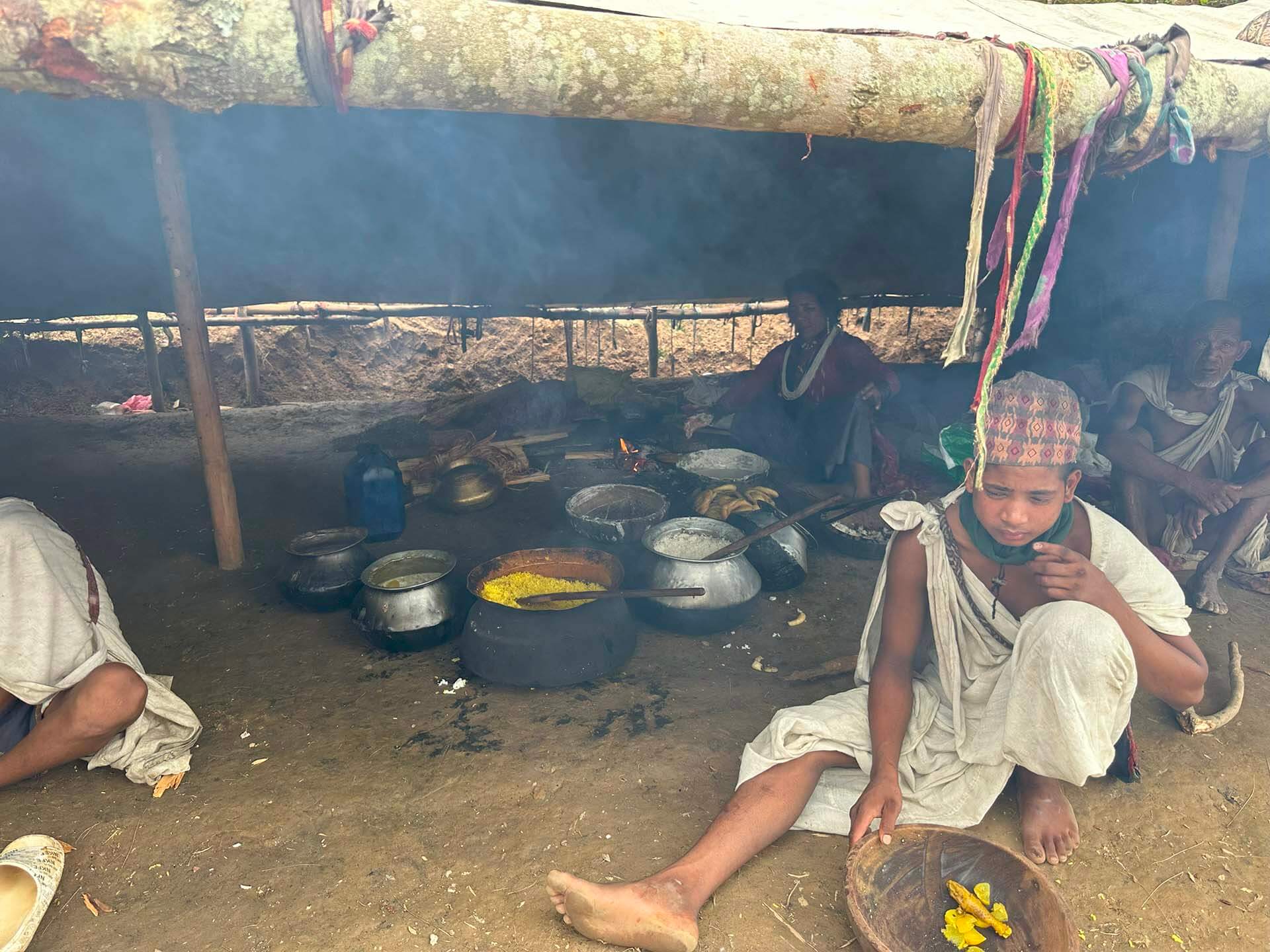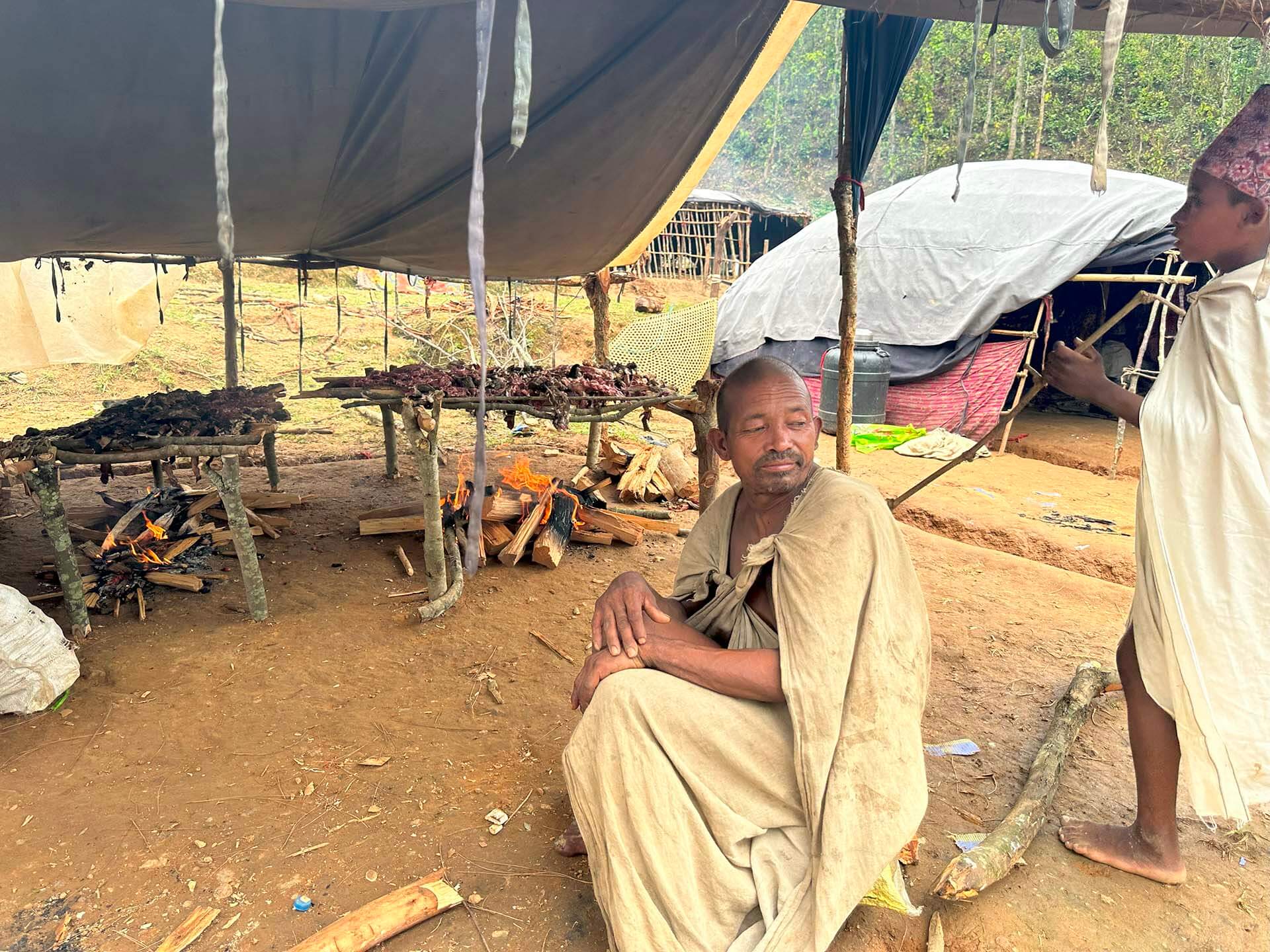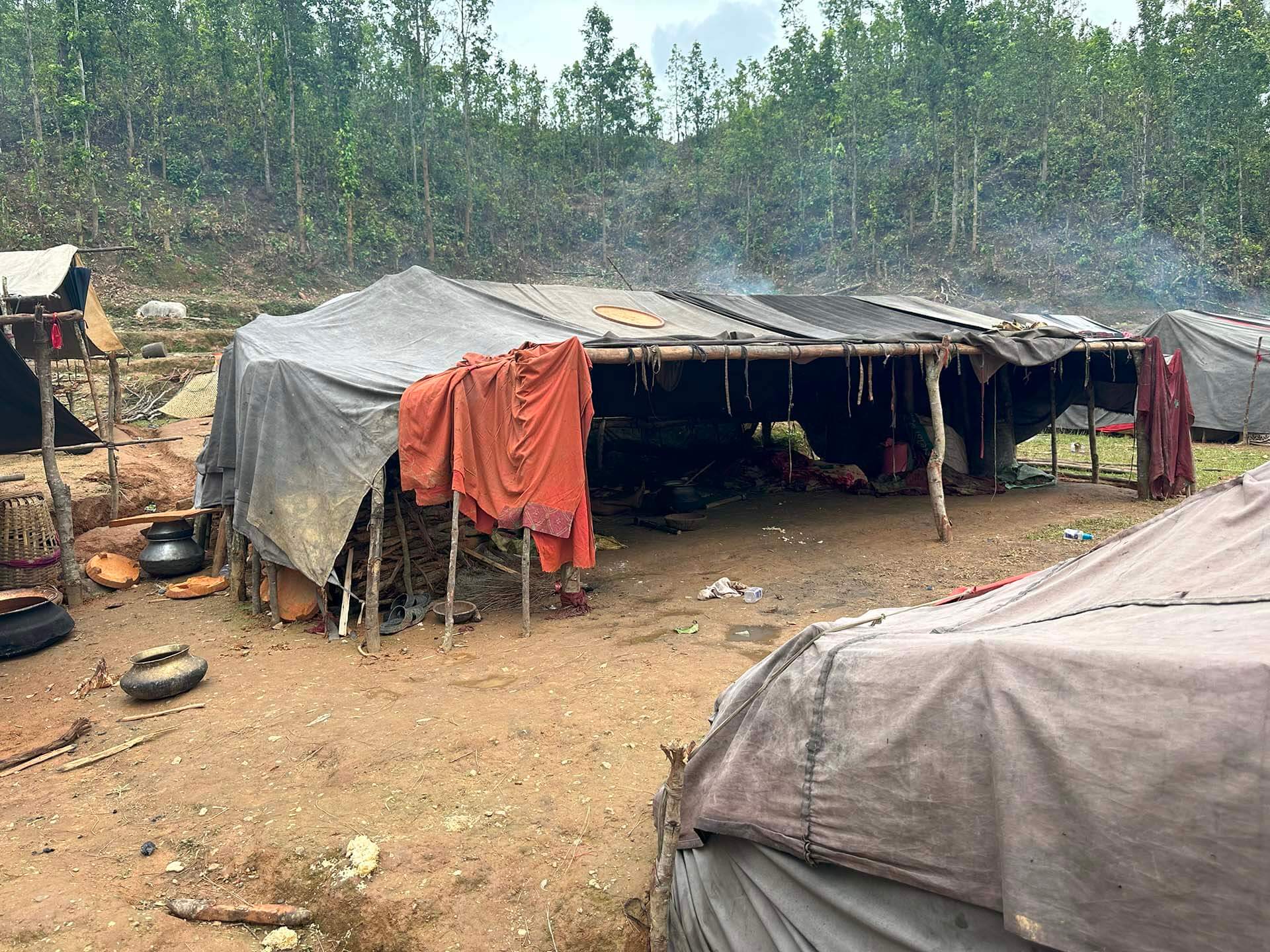Rautes, the only remaining nomads of Nepal who have been designated as endangered because of their dwindling numbers, face challenges in accessing food and water due to climate change. Extreme weather patterns hamper their migration patterns, lifestyle and livelihood too, writes Aadesh Subedi.
With the green hillocks in the background and tall trees as seeming sentinels, the tents of Rautes – the only remaining nomads of Nepal – are pitched in a clearing. Thin smoke can be seen from behind some tents. Goat meat being roasted on a raised platform is the source of the smoke.
The Rautes had a celebrated a festival the previous day. Now they are preparing a feast for the entire Raute population in the temporary camp, to celebrate the marriage of a 20-year-old youth and a much younger girl.
While the preparations are on, the children are learning the Nepali language through Kamchi, their mother tongue.
Some men are seen relaxing by their tents. And it is not because of the celebration alone. Climate change, along with other social pressures, has changed the lifestyle and livelihood of the nomadic Rautes.

The only remaining nomads of Nepal
A visit to the Rautes’ camp in the forest entails a motorbike ride for an hour from the headquarters of Dailekh district and then a 45-minute trek.
Rautes are the only nomadic people, and they mostly reside in the forest areas of Dailekh, a remote district in the western part of Nepal. The tribe stays in one place for a maximum of 45 days. They stay in tents made from wooden logs covered by plastic or tarpaulin sheets. They mostly hunt monkeys and collect food from the forest.
“Kusundas, the other nomadic tribe, settled down after the government provided them with shelters 40 years ago,” says Tek Prasad Pulami, information officer at Indigenous Nationalities Commission.
The Rautes stay isolated from other communities. The Raute community refuses citizenship.
“If they accept citizenship, they will need to settle down in one place and take up other work, and that’s why they refuse,” says Hira Singh Thapa, president of SOSEC Nepal, an NGO that works to improve the lives of the Raute tribe in Nepal.
But some Rautes agreed to take citizenship and have settled in the far west part of Nepal.

An endangered tribe
The Rautes numbered 618, as per Census 2011. The National Population and Housing Census 2021, puts their population at 566. However, this includes the Rautes who have settled down.
The nomadic Rautes in Dailekh number 142 according to local authorities.
“There were 152 Rautes when I started working with them five years ago,” says Ranjita BC of SOSEC, referring to the nomadic Rautes.
Since the population of Rautes is declining at a rapid pace, the government has designated them as an endangered tribe. “They were designated so in 2011,” says Pulami.
Though there are several causes for population decline, climate change has played a significant role.
Impact of climate change on forest food
The major impact of climate change on Raute’s life is a shortage of food.
The tribe majorly depend on forest produce such as tubers and herbs for food. But there has been a significant decline in the amount of such food in the forest as climate change has altered the temperature and precipitation pattern.
The increase in temperature and dry weather has been causing frequent wildfire in the country that causes the destruction of the forest food available for the Rautes.
“Such shortage of the food in the forests has forced Rautes to make frequent contact with the outside community as they cannot find enough food in the forest,” says Thapa.
Food deficit has caused different health problems in the community and there have been cases of maternal and child mortality causing a decline in their population according to Thapa.
Fishing is one of the main sources of food for Rautes but the decline in the number of fishes these days has also contributed to the food shortage.
Effects of climate change such as rising temperature and changing precipitation have caused a global decline infreshwater fish, according to a report from Food and Agriculture Organization (FAO).
“We don’t get as many fish in the river as in the past,” says Surya Narayan Sahi, chief of the Raute tribe.




Clockwise from top left: the Rautes continue their nomadic life, rejecting government’s offer to settle them in shelters; liquor bottles lying around the camp, indicating the men’s alcohol consumption; with wood fire from below, goat meat was being cooked for a feast; Ranjita of SOSEC Nepal has been teaching the Raute children for five years. Photos: Aadesh Subedi
Changing lifestyle
The Raute community are adept at making wooden utilitarian items.
But that scope is almost nil as wildfire destroys the wood in the forest, and there is decline in the quality of wood available. Nepal saw 3,337 wildfires while Dailekh had 29 fire incidents this season, according to data from the Ministry of Forest and Environment.
“We have almost stopped making wooden crafts these days,” says Sahi.
The Rautes used to barter their wooden items for food grains from the nearby community. This has also caused a food shortage for the tribe.
Based on an identity card they have been provided, the government distributes an allowance of NPR 4,000 (Nepalese rupees) – about USD 30 – to each of the individuals in the Raute community to ensure that they get proper food.
“Government started the allowance scheme 15 years ago,” says Thapa. The Rautes subsist only on this allowance.
The majority of that allowance, however, is spent on alcohol and rarely on food, which is also a major cause of death among Rautes according to Thapa. While they suffer from liver problems due to alcohol consumption, their food intake has also come down.


Left: eight goats were being cooked on different platforms, as a feast for the 142 Rautes in the camp. Right: the Rautes choose a place that is close to water sources. Photos: Aadesh Subedi
Changing migration patterns
Changing climate has altered the migration pattern of the tribe. Usually, the tribe stays in the upper hill during summer and the lower hill during winter.
In recent days, however, they stayed in the lower part of the hill near the river as the natural springs have started drying in the upper part of the hills. During this summer too they stayed at the base of the hill near a river for easy access to water. Due to their tradition, they don’t drink river water and thus have to walk for a long distance to fetch spring water.
“They walk almost an hour to collect drinking water from spring,” says Ranjita. She has been staying with the Rautes for five years and teaching the children in the camp.
Alteration in the migration pattern has forced the Rautes to stay in the hotter places even during summer.
“The temperature is rising at 0.056° Celsius per year,” says Indira Kandel, senior divisional meteorologist, at the Department of Hydrology and Meteorology.
The increase in temperature has further exacerbated their condition as they have to stay in extremely hot temperatures during summer.

Impact of erratic and intense rains
In recent years, Nepal has experienced erratic rainfall patterns, with minimal precipitation during dry days and maximum rainfall concentrated during rainy days.
Last year Nepal had almost normal rainfall i.e., normal compared to average precipitation data from 1971 to 2020. But the winter precipitation was only 12.9mm, which is only 21.5% of the previous average rainfall, according to Kandel.
Such erratic rainfall has affected the living conditions of Raute as they stay in small temporary shaky huts. However, the tribe has developed some of their own mechanism against such extreme weather patterns.
“The tribe used to use dry leaves as roof before. But after such roof started leaking in heavy rainfall, they started using plastics to cover their roof,” says Ranjita.
The nomads also make the drainage channel in their settlement to discharge excess water during heavy rainfall.
“Sometimes the rainfall is so heavy that the drainage channel and plastic roofs are not sufficient, and they are forced to spend several nights in flooded camps,” says Ranjita.

Towards sustaining the Rautes
Since the Rautes have significantly different traditions and lifestyles, a separate policy should be drafted to protect them, according to Sita Kumari Rana, a parliamentary member of Dailekh district, where the Rautes usually stay.
“Their unique culture and tradition are on the brink of extinction as their contact with outsiders has increased due to food shortage and haphazard construction of the road in the hilly areas of Nepal that pass through the forest where they used to live,” says Rana.
She suggests that the areas of the forest, where the tribes camp and move, should be especially protected for their settlement, prohibiting construction of the road and other infrastructure.
The allowance that the government has been giving in the form of money is often mis-utilised as it is used to buy alcohol and not nutritious food.
“The allowance should be given directly in the form of food and grains, as it is more effective in ensuring that they eat nutritious food,” says Rana. “Early detection and control of forest fire, support in locating natural sources of water are the other measures that could protect the tribe from changing climate.”
As the sun dips behind the hills, unmindful of the impact of the changing climate, the Rautes get ready to enjoy the feast.




